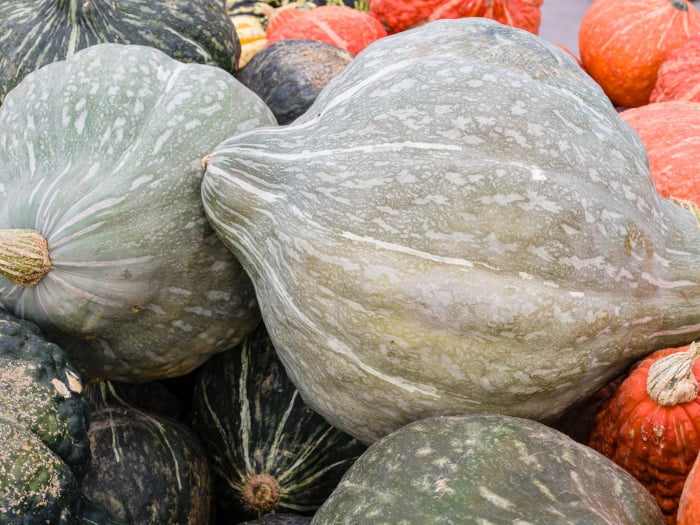It is best to not judge a book by its cover or a Hubbard squash by its exterior. What appears to be an almost caricaturized blue-gray exterior, reminiscent of Halloween decorations, houses a nutritionally-rich and tasty fruit. The flesh – mashed, roasted, or sautéed – adds a dash of rustic warmth to your winter days. However, that is not how it is categorized as winter squash. That has more to do with its hard exterior and seeds, and breaking it open can be quite fun. Let’s dive in to know how to cut, cook, and store Hubbard squash.
How to Select & Store Hubbard Squash?
You may generally find a Hubbard squash with the exterior being either orange or blue-green/gray in color. Both these varieties are edible. If you are harvesting them from your garden, wait till right before the temperature drops and the winter frost sets in. If the fruit is hard on the outside and well-formed, this is a good time to pick it. While you can leave it a few days into winter, it simply won’t be as tasty then.

Hubbard squash is named after Elizabeth Hubbard who sold the seeds to a trader. Photo Credit: Shutterstock
If you are buying it from the market, what you are looking for is a fruit with a hard exterior and a matte-looking skin. A bright shiny rind may look attractive, but it represents a squash that isn’t well-formed yet. You may find the entire fruit in the market, but buy pre-cut pieces if available and if you are buying it for a single, small meal.
Serving Size : Nutrient Value Water [g] 88 Energy 40 Energy [kJ] 167 Protein [g] 2 Total lipid (fat) [g] 0.5 Ash [g] 0.8 Carbohydrate, by difference [g] 8.7 Fiber, total dietary [g] 3.9 Sugars, total including NLEA [g] 3.95 Calcium, Ca [mg] 14 Iron, Fe [mg] 0.4 Magnesium, Mg [mg] 19 Phosphorus, P [mg] 21 Potassium, K [mg] 320 Sodium, Na [mg] 7 Zinc, Zn [mg] 0.13 Copper, Cu [mg] 0.06 Manganese, Mn [mg] 0.18 Selenium, Se [µg] 0.5 Vitamin C, total ascorbic acid [mg] 11 Thiamin [mg] 0.07 Riboflavin [mg] 0.04 Niacin [mg] 0.5 Pantothenic acid [mg] 0.4 Vitamin B-6 [mg] 0.15 Folate, total [µg] 16 Folate, food [µg] 16 Folate, DFE [µg] 16 Choline, total [mg] 11.8 Vitamin A, RAE [µg] 68 Carotene, beta [µg] 820 Vitamin A, IU [IU] 1367 Vitamin E (alpha-tocopherol) [mg] 0.16 Vitamin K (phylloquinone) [µg] 1.3 Fatty acids, total saturated [g] 0.1 12:0 [g] 0 14:0 [g] 0 16:0 [g] 0.09 18:0 [g] 0.01 Fatty acids, total monounsaturated [g] 0.04 16:1 [g] 0 18:1 [g] 0.03 Fatty acids, total polyunsaturated [g] 0.21 18:2 [g] 0.08 18:3 [g] 0.13 Tryptophan [g] 0.03 Threonine [g] 0.06 Isoleucine [g] 0.08 Leucine [g] 0.11 Lysine [g] 0.07 Methionine [g] 0.03 Cystine [g] 0.02 Phenylalanine [g] 0.08 Tyrosine [g] 0.07 Valine [g] 0.09 Arginine [g] 0.11 Histidine [g] 0.04 Alanine [g] 0.08 Aspartic acid [g] 0.22 Glutamic acid [g] 0.35 Glycine [g] 0.07 Proline [g] 0.07 Serine [g] 0.08 Sources include : USDA [1]
It is best to cure it before you store it. For this, leave it for about 10 days in a well-ventilated rack, till the skin hardens and the moisture has evaporated. To store your whole squash safely for a few days, find a cool and dry place, preferably not on the floor. Wipe the skin clean, ensure it is dry, and then you can place it on a shelf and cover it with a cloth. This can make it last for over three months. However, ensure that you check on it every few days.
How to Cut Hubbard Squash?
If you have brought home the tough squash and are preparing to cut it open, get ready to summon your inner child. One of the effective ways of cutting it is by letting it break open by dropping it from a height. Wrap it securely in a cloth or plastic bag and allow this bag to fall from a height.
Another way of doing this is to take a meat cleaver, or a similar knife, and cut it open. The job may not be as successful with regular vegetable knives. Start by applying single-point pressure on the squash with one sharp point and then drag the blade further from there in a single direction. To help break down the bigger pieces, you can microwave them for a couple of minutes, when needed.
How to Cook Hubbard Squash?
The humble and tough-looking Hubbard squash may not be liked by everyone, but its nutritional value remains undisputed. While they are rich in sugar, they also come packed with calcium, magnesium, and potassium. A Harvard Health article notes that potassium plays an important role in maintaining blood pressure. However, the average American diet may contain twice as much sodium as potassium, which could lead to long-term adverse effects on one’s health. [2] [3]
To bring out the best balance of taste and nutrition in Hubbard squash, as well as to use it easily, start by roasting it. For this, take pieces of the squash and with the skin side down, hold it over a grill or an open flame, if safe. This will give you a one-side charred piece of winter squash with flesh soft enough to be scooped out. The longer you leave it over the fire, the softer it gets.
Here are a few ways you can use Hubbard squash:
- Add it to mashed potatoes or sweet potato mash
- Use it as an addition to your winter salads
- Add the firmer pieces to your breakfast hash recipe
- The roasted pieces can be pureed to be used in pies
- Season the roasted pieces and pair it with your meals
Hubbard squash has been one of the staples squashes of ancient civilizations. While it may not always have been popular with everyone, there is no denying its impressive nutritional values and adaptable flavor profile. If you haven’t given it a try yet, this winter is the season to add more squashes to the mix.
